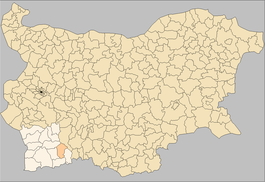Garmen Municipality
|
Garmen Municipality Община Гърмен |
||
|---|---|---|
| Municipality (Obshtina) | ||
|
||
 Location in Blagoevgrad province |
||
| Coordinates: 41°36′N 23°49′E / 41.600°N 23.817°ECoordinates: 41°36′N 23°49′E / 41.600°N 23.817°E | ||
| Country | Bulgaria | |
| Province (Oblast) | Blagoevgrad | |
| Seat | Garmen | |
| Government | ||
| • Mayor | Minka Kapitanova (local coalition) | |
| Area | ||
| • Total | 388.48 km2 (149.99 sq mi) | |
| Elevation | 605 m (1,985 ft) | |
| Population (2011) | ||
| • Total | 14,981 | |
| • Density | 38.56/km2 (99.9/sq mi) | |
| Time zone | EET (UTC+2) | |
| • Summer (DST) | EEST (UTC+3) | |
| Website | www |
|
Garmen Municipality (Bulgarian: Община Гърмен, Obshtina Garmen) is situated in the southeastern part of Blagoevgrad Province in Southwestern Bulgaria. It is a rural municipality, composed of 16 villages. The administrative center is the village of Garmen, but the most populated village is Ribnovo. The municipality lies in the western part of the Rhodope mountains.
The municipality of Garmen has been a home to many tribes throughout the years, but most important have been the Thracians, Slavs and Protobulgarians. The Thracian tribe of Bessi was the main tribe that settled in the region and there are a large number of remains left in the area, proof of their rich life here. The villages of Blatska, Debren, Dabnitsa and Hvostyane have found fragments of Attic vessles and there are mound necropolises.
In about 146 AD, after long battles between Roman troops and Thracians, the area around Gotse Delchev fell to Roman rule. In 106 the emperor Trajan built the city Nicopolis ad Nestum in honor of the defeat. This town was destroyed at the end of the 6th century by the Slavs and the tribe of the Smolyani settled here. The Slavs were farmers and herdsmen. They grew millet, wheat, flax, hemp and leguminous plants and they also bred birds, cattle, sheep and goats.
Garmen is mentioned several times in the Ottoman registers during the Ottoman rule and they also built a Turkish grange in the area where Nicopolis ad Nestum was located. Until the 19th century the municipality was mainly a farming area and a few men worked as builders in the interior of the country and in the Aegean region. The first schools and churches were built in the area during the Bulgarian renaissance. Garmen's church was named after St. George. There are built the Assumption church in Ognyanovo, St. Nicholas in Kovachevitsa, St. Paraskeva in Leshten, St. Paraskeva in Skrebatno and St. Dimitar in Osikovo.
During the Russo-Turkish war (1877–1878) and during the Balkan wars (1912–1913) the population in the municipality joined volunteer troops to fight. In 1901 a volunteer "militia" was formed by Stoyko Pashkulev. The area was liberated from the Ottoman rule in 1912.
Most of the municipality is mountainous and forested. There are coal deposits near Baldevo and hot springs near Ognyanovo.
...
Wikipedia


